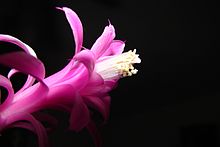Aporocactus flagelliformis
aus Wikipedia, der freien Enzyklopädie
| Aporocactus flagelliformis | ||||||||||||
|---|---|---|---|---|---|---|---|---|---|---|---|---|

Aporocactus flagelliformis | ||||||||||||
| Systematik | ||||||||||||
| ||||||||||||
| Wissenschaftlicher Name | ||||||||||||
| Aporocactus flagelliformis | ||||||||||||
| (L.) Lem. |

Aporocactus flagelliformis ist eine Pflanzenart aus der Gattung Aporocactus in der Familie der Kakteengewächse (Cactaceae). Das Artepitheton flagelliformis leitet sich von den lateinischen Worten flagellum für ‚Peitsche‘ sowie -formis für ‚-geformt‘ ab und verweist auf die langen, schlanken Triebe der Art.[1] Spanische Trivialnamen sind „Flor de Látigo“, „Floricuerno“, „Junco“, „Junquillo“ und „Nopalillo“.
Aporocactus flagelliformis wurde von den Kakteengesellschaften der drei deutschsprachigen Länder Deutschland (DKG), Österreich (GÖK) und Schweiz (SKG) zum Kaktus des Jahres 2024 gewählt.[2]
Beschreibung
[Bearbeiten | Quelltext bearbeiten]Aporocactus flagelliformis wächst kriechend und/oder hängend. Die Triebe sind schlank im Querschnitt rund und von graugrüner Farbe. Sie werden bis zu 1 Meter lang und sind nur 1,2 bis 2 Zentimeter im Durchmesser groß. Sie haben 8 bis 13 niedrige Rippen. Die eng stehenden Areolen sind mit 15 bis 20 feinen, rötlich-gelben Dornen ausgestattet. Die rot bis purpurrosa-farbenen Blüten erreichen eine Größe von 5 bis 8 Zentimeter Länge und 2,5 bis 4 Zentimeter im Durchmesser. Sie erscheinen seitlich und sind aufwärts etwas gebogen und zygomorph. Die Früchte sind rot, kugelig bis borstig und 1 Zentimeter im Durchmesser groß.
Verbreitung, Systematik und Gefährdung
[Bearbeiten | Quelltext bearbeiten]Aporocactus flagelliformis ist in den mexikanischen Bundesstaaten Guanajuato, Hidalgo, Mexiko, Oaxaca, Puebla, Querétaro, San Luis Potosí und Veracruz verbreitet und kommt in Höhenlagen oberhalb von 2000 m vor.
Die Erstbeschreibung als Cactus flagelliformis erfolgte 1753 durch Carl von Linné.[3] Charles Lemaire stellte die Art 1860 in die Gattung Aporocactus.[4] Weitere nomenklatorische Synonyme sind Cereus flagelliformis (L.) Mill. (1768) und Disocactus flagelliformis (L.) Barthlott (1991)[5].
In der Roten Liste gefährdeter Arten der IUCN wird die Art als „Near Threatened (NT)“, d. h. als gering gefährdet geführt.[6]
Nachweise
[Bearbeiten | Quelltext bearbeiten]Literatur
[Bearbeiten | Quelltext bearbeiten]- Edward F. Anderson: Das große Kakteen-Lexikon. 2. Auflage. Eugen Ulmer KG, Stuttgart 2011, ISBN 978-3-8001-5964-2, S. 184.
- Ulises Guzmán, Salvador Arias, Patricia Dávila: Catálogo de cactáceas mexicanas. Universidad Nacional Autónoma de México, Mexiko-Stadt 2003, ISBN 970-9000-20-9, S. 25.
Einzelnachweise
[Bearbeiten | Quelltext bearbeiten]- ↑ Urs Eggli, Leonard E. Newton: Etymological Dictionary of Succulent Plant Names. Springer, Berlin/Heidelberg 2010, ISBN 978-3-642-05597-3, S. 84.
- ↑ Kaktus des Jahres 2024 – Von Anfang an dabei, der Peitschenkaktus Aporocactus flagelliformis. Abgerufen am 12. November 2023.
- ↑ Carl von Linné: Species Plantarum. Band 1, 1753, S. 467 (online).
- ↑ Charles Lemaire: L'illustration horticole. Band 7, Misc. 68 (online).
- ↑ Nadja Korotkova, Thomas Borsch, Salvador Arias: A phylogenetic framework for the Hylocereeae (Cactaceae) and implications for the circumscription of the genera. In: Phytotaxa. Band 327, Nummer 1, 2017, S. 20 (doi:10.11646/phytotaxa.327.1.1).
- ↑ Disocactus flagelliformis in der Roten Liste gefährdeter Arten der IUCN 2013.2. Eingestellt von: Hernández, H.M., Gómez-Hinostrosa, C. & Cházaro, M., 2009. Abgerufen am 5. Januar 2014.
Weblinks
[Bearbeiten | Quelltext bearbeiten]Text is available under the CC BY-SA 4.0 license; additional terms may apply.
Images, videos and audio are available under their respective licenses.

